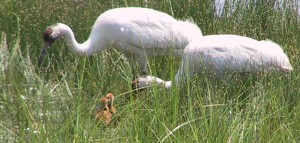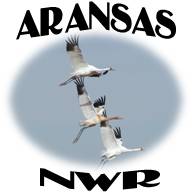Mark Bidwell, Whooping Crane Coordinator for the Canadian Wildlife Service reports that he and Kathy St. Laurent (CWS-Ontario) completed this year’s survey of nesting whooping cranes in and around Wood Buffalo National Park (WBNP) last week. Mark advised that, “We conducted the survey in close cooperation with Parks Canada (PCA) and were accompanied on one day by John McKinnon (PCA) who will also assist during the August survey. All in all, we flew 17.7 hours in a Bell 206 helicopter and 7.1 hours in a Cessna 210 fixed wing. In addition to surveying the usual nesting territories, we did some reconnaissance work in areas identified as potential habitat but that hadn’t been searched recently.”
Mark continued, “We’re pleased to report that we detected a record 75 nests, including a few in areas apparently being colonized by new nesting pairs. We made a number of changes, on scientific and safety grounds, to the way the survey is conducted so were happy to have good results despite the changes. We’ll revisit the nesting territories in August to assess productivity. We will also take colleagues from USGS, USFWS and ICF to mark an additional 10 to 12 birds as part of the ongoing telemetry study that aims to better understand the ecology of, and threats faced by, the Aransas-Wood Buffalo population.”
Tom Stehn, U.S. Fish and Wildlife Service added that, “The record of 75 nests found on the May surveys, surpasses by one the 74 nests found last year. Habitat conditions looked good, so hopes are high to have a good production season and an increase for the flock in 2011. With luck, a record 300 whooping cranes could make it to Aransas this fall!”
Mark Bidwell also pointed out that, “I appreciate the support for this year’s survey from CWS and Parks Canada, and hope to build on this cooperation in the coming months and years. Many thanks to Kathy St. Laurent and John McKinnon, and especially to Dave Duncan, Mark Wayland, Lesley Dunn, and Stu MacMillan who made their participation in this year’s survey possible.
 The U.S. Fish and Wildlife Service’s Necedah National Wildlife Refuge (NWR) and the Whooping Crane Eastern Partnership (WCEP) are celebrating another success in efforts to reintroduce a wild migratory whooping crane population in eastern North America.
The U.S. Fish and Wildlife Service’s Necedah National Wildlife Refuge (NWR) and the Whooping Crane Eastern Partnership (WCEP) are celebrating another success in efforts to reintroduce a wild migratory whooping crane population in eastern North America.
